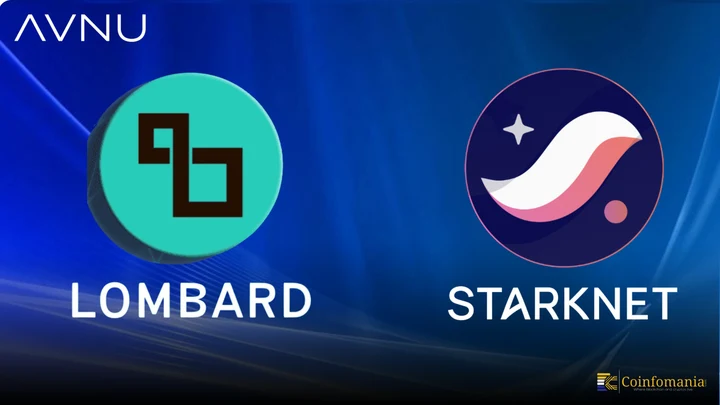AVNU Confirms LBTC Trading Launch After Starknet Partnership with Lombard Finance
0
0

On May 14, AVNU posted on X that LBTC would soon trade on its platform. AVNU Exchange is a decentralized exchange on Starknet. The news came minutes after Starknet announced a partnership with Lombard. The partnership aims to bring LBTC into Starknet’s ecosystem. LBTC is a liquid-staked token fully backed by Bitcoin at a one-to-one rate. This sequence of announcements not only expands utility for Bitcoin but also suggests deeper integration between trading platforms. AVNU’s announcement emphasized smoother trading for LBTC holders
Starknet and AVNU Enable DeFi Access for Bitcoin Holders
Integrating LBTC into Starknet’s DeFi expands Bitcoin use beyond storing value. The 1:1 BTC backing ensures trust and stability. Users can bridge LBTC onto the Starknet Blockchain in seconds, and they can also redeem it at any time. The move lets holders earn yield via Lombard vaults. Lending, borrowing, and liquidity provision become possible with Bitcoin. This change does not alter Bitcoin’s security model. It simply adds new ways to use Bitcoin funds. New tools unlock idle Bitcoin within decentralized platforms. Developers can build fresh services on this open network.
The AVNU Exchange serves as the trading hub for LBTC. It gathers liquidity from many sources. Custom solvers optimize trade routes for the best pricing. This system pulls liquidity from JediSwap and MySwap. It also taps into other AMMs on Starknet. By offering LBTC support, AVNU Exchange boosts its DeFi suite. Users can swap tokens without using a central party. The platform highlights fast trades and easy swaps. Technical depth underpins performance more than marketing. It aims for fluid and reliable trading experiences. No complex setups are needed for LBTC swaps.
Role of Starknet in Expanding Bitcoin’s Use in Smart Contracts
Lombard Protocol’s LBTC is key to this change. It lets Bitcoin stay in DeFi after staking. Users convert BTC to LBTC via the Babylon protocol. Each LBTC is backed one-to-one by real Bitcoin. This method keeps the original Bitcoin safe without sale. Staked tokens power financial activities across decentralized platforms. Lombard turns idle Bitcoin into active capital. This strategy aims to widen DeFi’s total locked value. Users maintain full ownership of the underlying Bitcoin. The model supports seamless asset transfers. No need to withdraw original BTC during yield farming. This blend of staking and DeFi unlocks fresh money streams.
Lombard Protocol joined Starknet Blockchain to link Bitcoin liquidity to a modular execution layer. Starknet aims to bridge the Ethereum and Bitcoin networks. The partnership allows for the deployment of Bitcoin funds in smart contracts. Institutions and individual users gain from Starknet’s scalability. Developers can build composable BTC-based financial tools. Starknet’s security model remains intact for Bitcoin assets. Through this link, Bitcoin use cases on Starknet could grow. The teamwork sets a path for new decentralized financial products. The move highlights growing cross-chain integration trends. This effort may attract more BTC capital to Starknet.
Lombard DeFi Vault Simplifies Bitcoin Yield Strategies
At the core of this process lies the Lombard DeFi Vault. Built with Veda, this vault takes LBTC and other Bitcoin derivatives. Users receive LBTCv tokens that show their share and earned rewards. Veda helps turn these returns into easy-to-handle tokens. The vault mixes lending, liquidity, and trading strategies. It also tokenizes yield for improved transparency. The goal is to simplify DeFi for all user levels. Non-technical users can join without complex steps. It builds on automated strategies to boost returns. LBTCv tokens track real-time performance.
This vault automates rebalancing and compounding rewards. It puts earnings back into its pool each cycle. Strategies include lending via Morpho protocols and tight-range liquidity on Uniswap. It also uses yield trading through Pendle. This mix spreads risk across multiple methods. Users avoid manual position management tasks. Real-time share tracking shows individual stakes. Automated steps aim to match changing market conditions daily. Compounding boosts yields while controlling exposure. Low fees make this vault cost-efficient for small investors. No constant monitoring is required.
Starknet and AVNU’s Push to Activate Bitcoin On-Chain
LBTC’s role goes beyond vaults. It serves as DeFi collateral and a multi-chain asset. Traders use it for cross-chain transfers. The token can back loans on various platforms. The broader goal is to make Bitcoin productive. Starknet supports this vision by hosting LBTC. AVNU Exchange will offer optimized LBTC trades across AMMs. Market adoption will depend on user interest and network growth. Together, these steps may reshape Bitcoin finance on-chain. These changes highlight a shift toward modular financial layers. Education is key for user trust and uptake.
The post AVNU Confirms LBTC Trading Launch After Starknet Partnership with Lombard Finance appeared first on Coinfomania.
0
0
 Manage all your crypto, NFT and DeFi from one place
Manage all your crypto, NFT and DeFi from one placeSecurely connect the portfolio you’re using to start.






